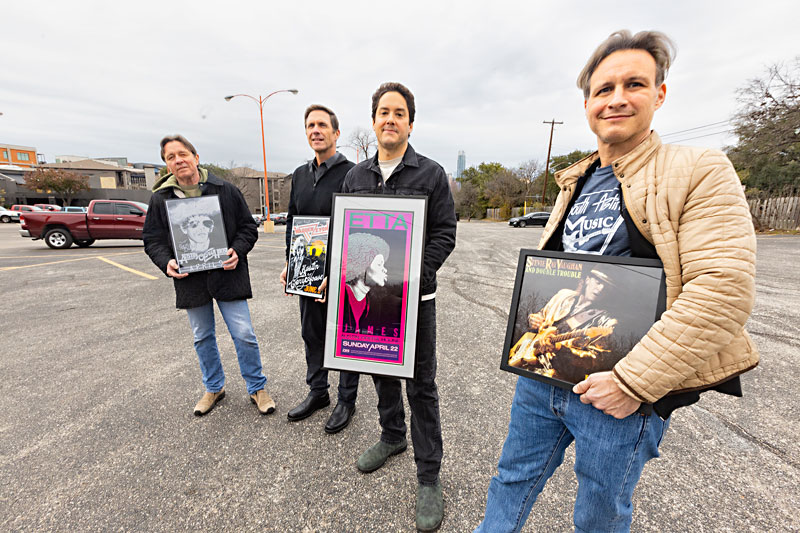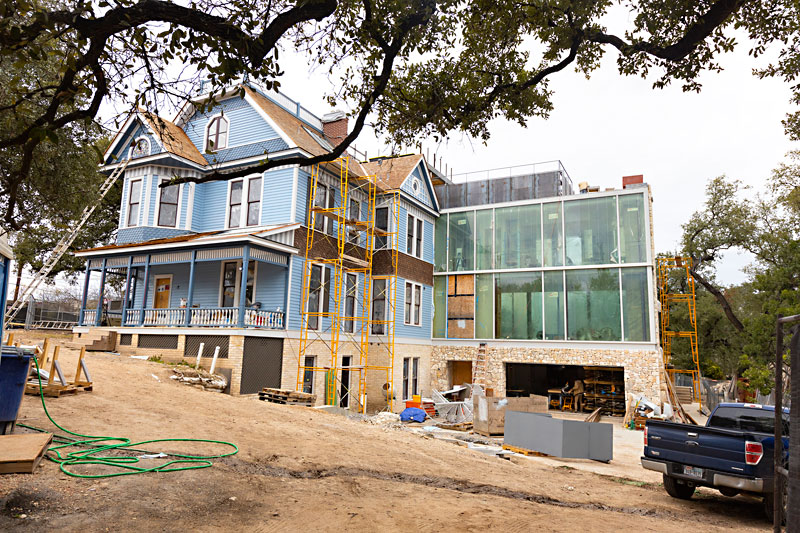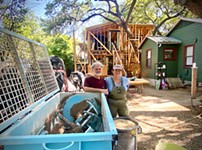Proposed Development Would Revive Austin Opera House but Faces Neighbor Opposition
200 Academy Drive: Big hit or last call?
By Kevin Curtin and Mike Clark-Madison, Fri., Jan. 21, 2022
The long, one-story, gray building on the oddly shaped parcel at 200 Academy Dr., within walking distance of the South Congress strip, looks wholly unremarkable today. But it's an Austin cultural landmark dating back 45 years, home to vitally important sites on the map of the city's music scene, and poised for a renaissance as part of a mixed-use redevelopment on what's become very valuable land in the urban core.
But for that to happen, the current owners of 200 Academy need to overcome implacable opposition from neighbors and gain nine votes on a 10-1 City Council that often splits 7-4 on the relevant land use issues. With Council slated to take its first vote on the case at its January 27 meeting, we'll soon know: Is it showtime for a new Austin Opera House, or is it last call for live music off Music Lane?
Where Magic Happened
It used to be an event and meeting space attached to the Terrace Motor Court, one of the Southside's many motels dating back before the interstate, when South Congress was the highway into town from points south. Then Willie Nelson bought it, and in the summer of 1977 the Austin Opera House (known colloquially as "the Opry House") debuted as a 1,700-capacity concert hall, with stadium seating and standing room in front of the stage. It sat on a fragment of land, with an enormous surface parking lot facing the street, tucked between historic Fairview Park – part of the super-neighborhood that most latter-day Austinites simply call Travis Heights – and a SoCo that was just as active and commercial, but extremely different in character, from the strip that exists today. Its remaining motels rented rooms by the hour.
The stony cowboy poets of progressive country held court there, and so did Austin's blues big shots (Asleep at the Wheel's Served Live and Stevie Ray Vaughan's Live Alive albums both capture performances from that stage), but the venue – managed by late concert promoter and Austin music scene legend Tim O'Connor – hosted a wide range of bigger touring acts, in a range of genres that included most everything except opera: Iggy Pop, Red Hot Chili Peppers, the Eagles, Patti Smith, Muddy Waters, Lou Reed, King Crimson, Butthole Surfers, BB King, Tom Waits. And, of course, Willie and his friends. "I grew up just worshiping Ray Charles, so getting to listen to him play with Willie was magic – it's one of my favorite memories there," says Nelson's nephew Freddy Fletcher, who founded Arlyn Studios on the same property in 1984.
The concert hall, which was renamed the Terrace (and still booked by O'Connor) after Nelson sold the property in 1988, stopped operating as a venue in 1992. Thirty years later, the stage still stands – with portable offices built atop it by later tenants. "It was one of the cornerstones of Texas music in its time," Fletcher says. "That history is really important to me and if we don't preserve it, then shame on us."
Fletcher and his Arlyn Studios partner Will Bridges are now working with 200 Academy's current owner Chris Wallin and his architect/agent Richard Weiss (also a 30-year veteran of the Austin music scene, and the lead architect for Alamo Drafthouse) to bring the Austin Opera House back to life as part of the new mixed-use development – not a re-creation but a reclaiming of the venue's original stage and walls. Via Fletcher, whose mom is Sister Bobbie Nelson, it'll still be in the family.
Fletcher has already, as a developing partner of ACL Live at the Moody Theater, gotten some experience at bringing new life to Austin music mainstays. Bridges, younger than Fletcher, has likewise been a deeply engaged preservationist owner/partner in iconic Austin establishments including the current Antone's location, Cisco's, Deep Eddy Cabaret, and Lamberts Downtown Barbecue.

Building What Austin Needs?
Wallin admits that he was oblivious to the property's musical history when he initially purchased it in 2018; the shuttered Terrace had long been used as office space. But he quickly got a word-of-mouth education from folks with memories of shows at the Opera House, including Weiss as well as Fletcher and Bridges.
"Over a period of time I just talked to more and more people and began to understand the value and importance of this venue, and it really changed my whole perception of what could be done," Wallin said. "So then we started to approach it from a different angle; let's try to preserve Arlyn Studios and come up with something more mixed-use, with a buffer of residential development. And so we use that as our guiding principle and what we're trying to build."
The problem Wallin and Weiss now face is a tricky variation of the usual NIMBY vs. YIMBY conflicts that get litigated through Austin's baroque and broken land use regulations. Technically, they don't need a zoning change at 200 Academy to build high-intensity commercial (like a music venue, or a motel) or to build up to 36 or 54 units per acre (depending on those units' size) of multifamily on the eastern edge of the property along Melissa Lane, or even to sell alcohol. That's all allowed by 200 Academy's base zoning, which has been in place since the city adopted its current land use regulations in 1982, though Wallin and Weiss will need to obtain a conditional use permit (from the city Planning Commission) if their project ever gets to a site plan, which will serve as a way for the neighbors to hold them accountable for their promises.
"With the existing base zoning, the project can provide a residential buffer with below-grade parking," reads the property fact sheet prepared by Wallin, Weiss, et al. "The original Opera House will be revitalized with housing above, surrounding retail and a central park replacing a 70-year-old parking lot. We are not requesting upzoning the property, increasing height through a density bonus, or seeking any variances from code. This project can provide much needed housing with zero displacement, adjacent to two transit corridors."
A High Hurdle to Clear
None of that matters unless Wallin and Weiss can convince Council to remove 200 Academy from the Fairview Park Neighborhood Conservation Combining District, which was adopted in 1986 – which the powerful South River City Citizens neighborhood association and the Greater South River City neighborhood planning contact team both firmly oppose, although both are willing to amend the restrictions it imposes. Such NCCDs, as everyone calls them, are overlays enabled by state law, a tool cities could use to protect historic neighborhoods before they had the power to create local historic districts. There are only a few in Austin – Fairview Park was the first, followed by North University and Hyde Park, along with the business corridors along E. 11th and 12th streets. Most of Austin's were already in place or in progress by the time the city launched its neighborhood planning program in the late 1990s; the neighborhood plan that includes Fairview Park was adopted in 2005, and its future land use map, or FLUM, calls for 200 Academy to be office space. Wallin and Weiss first asked for an amendment to the FLUM in 2019, which was put on hold until they submitted the subsequent zoning case to lift the NCCD a year later. That led to a traffic analysis and ongoing talks with an ad hoc SRCC/GSRC subcommittee, mostly composed of homeowners near 200 Academy, which had moved the two sides closer but not bridged irreconcilable differences over the size of the music venue by the time the case reached the Planning Commission in August.
On the YIMBY side of the land use wars, NCCDs have a really bad reputation, similar to that of planned-unit developments on the NIMBY side. Both of these tools allow for deviations from the 1982 Land Development Code to create, or preserve, or re-create places that would otherwise be illegal, which makes the other side suspicious. The 200 Academy case highlights what urbanists see as the kind of mischief weaponized NCCDs can create, and what preservationists see as absolutely essential safeguards.
Obviously, neither the Opera House nor the Terrace Motor Court were part of the historic Fairview Park neighborhood, which dates back to the late 19th century, conceived by developer Charles Newning as an (all-white, outside the city limits and taxing authority of Austin) large-lot garden suburb, like Tarrytown would later become. Newning largely fell short of his mark because the tony Austin bourgeoisie did not want to cross the river; the irregular large lots remain, some with their 19th century structures, others with much later homes clustered around the mid-20th century. Fairview Park was just last year granted a listing in the National Register of Historic Places – that historic district does not include 200 Academy within its boundaries.
Prior to the Fairview Park NCCD's enactment, city planners had consistently treated 200 Academy and the Music Lane area as a transitional buffer between a de facto highway and a single-family neighborhood. But the NCCD specifically includes 200 Academy (but not adjoining properties to the west along Music Lane or South Congress) to impose restrictions that reflect the neighbors' very different view of the value of what went on at the Opry House. Those restrictions, Weiss points out with great frustration, would not allow Wallin to rebuild the structure already standing, let alone add more density: single-family compatibility standards, only office uses allowed on the commercial part, a cap of 15 units per acre on residential, and no alcohol sales.
One of the closest neighbors, Brian Beattie, is also a noted Austin musician. His wife bought their house on Ravine Drive (just off Academy Drive to the south) "in 1993, so she experienced the tail end of the 'Austin Opera House' era," he wrote in opposition to Wallin and Weiss' case at the Planning Commission. "Even though the neighborhood had successfully limited the number of events that [the Terrace, by that point] could host, it was still a great burden on the residents. The overflow parking, the trash and noise, and the sheer volume of drunken patrons before and after the events were incompatible with a residential neighborhood. The proposed plans for 200 Academy ... would shatter the balance of the neighborhood, which is already under pressure from the dense development on South Congress."

Hearts and Minds at SRCC?
After that August Planning Commission hearing, the case didn't make it to the Council agenda until November, at which time it was postponed for more than two months, to the first meeting of the year on Jan. 27. In those intervening 10 weeks, neighbors succeeded in filing a valid petition against removing 200 Academy from the NCCD, which requires the support of the owners of 20% of the land within 200 feet of the site, which in this case means about five people. Weiss suggests a potential loophole that would remove the protest, but Austin's track record at defending such decisions in court is pretty poor at present. So he and Wallin, and Fletcher and Bridges, will likely need nine votes.
That means they'll need to secure support from at least a couple of the Council members who've heretofore taken pride in supporting neighborhoods in such disputes and are loath to ever vote against a valid petition. One of these is the CM in whose district 200 Academy lies, Kathie Tovo – a veteran defender of neighborhoods' perceived interests and rights, including against development on South Congress, but now the CM representing most of Austin's Downtown entertainment district (and most of South Congress) and a champion of both the contributions and the needs of Austin's live music industry.
On Tuesday, Jan. 18, Wallin and Weiss took advantage of what may be their final opportunity to change hearts and minds in the neighborhood, at SRCC's general membership meeting, open to the public and streamed on Zoom. Like many of Austin's established umbrella neighborhood associations, SRCC (founded in 1972) has a fairly bureaucratic structure, with lots of committees, and both it and the contact team "typucally support the nearest neighbors," said Laura Toups, a local civil engineer and member of both bodies, who lives a block from 200 Academy (but not within 200 feet).
But at Planning Commission, both groups offered to support the staff recommendation on the case, which would amend the FLUM and the restrictions within the NCCD without removing it and allow for the planned office (including Arlyn) and residential uses. Staff, the neighbors, and Wallin and Weiss all want different square footage limits on the "cocktail lounge" use (what the LDC labels the CS-1 zoning category required for alcohol sales). The neighbors currently would like that capped at 2,500 or 3,000 square feet, the size of the nearby Continental Club; they've also broached recommendations that Wallin and Weiss should build a listening room à la the old Cactus Cafe. That stance is largely "based on the traffic and parking impact," says Toups. "But that sized venue is simply incompatible at that location. It's just too large and too many people. A destination music venue on a residential connector street is just ridiculous."

Still a Thing Worth Doing
The neighborhood's stance has slowed, but not stalled, the 200 Academy team's roll. Their original intention was to bring the Opera House back exactly as it was, at 42,000 square feet, but that's been scaled back to a 17,000-sq.-ft. size that can accommodate 1,200 fans, which from Fletcher and Bridges' informed perspective is just the right size.
"The size of this venue represents filling a huge void in Austin's live music ecosystem and, therefore, also in the promoting ecosystem," Bridges says. "Austin does not have a single indoor, standing-room venue between 700 and 1,700 capacity" – a niche O'Connor helped fill at the Opera House/Terrace and then, later, at the Austin Music Hall. "I describe it as this missing middle. We have lots of artists who sell out Antone's; then where to next? It's a big gap to sell out Stubb's or ACL Live or even Scoot Inn. The outdoor venues we have in those size groups are great, but they're somewhat limited in frequency of shows due to weather and outdoor amplified sound restrictions. Artists used to have organic stairsteps in front of them to build their careers: Liberty Lunch was 1,100 [total capacity], La Zona Rosa was 1,300, and the Armadillo [World Headquarters] was 1,500."
Bridges also sees reopening the Opera House as a needed win to make sure music continues to have a place in the heart of Austin. Citing the city's 2015 Music Census, Bridges points out that venues have had a hard time operating in the Downtown core. "Then we know from other cities that are farther along in their life cycle, when they lose the creative sectors near their urban core, it's not a good sign."
The supportive creative elements in 200 Academy's plan include an Austin music museum adjoining the Opera House venue, and work spaces for music industry businesses (in addition to Arlyn). Still, musicians themselves remain wary of projects that have music at to the forefront of their branding but don't reflect the music culture or are too expensive for musicians to even set foot in.
"To not just be using music's name and saying, 'Oh, we've got music here,' and then it's just some kind of cheesy place, you have to put the right people in charge," Wallin responds. "I don't have that music history or background and I don't claim to and I wouldn't want to be in charge or running it, but I'm a big fan of Freddy and Will and they do a great job at keeping the history and culture.
"In terms of making it affordable, we are looking to do an affordable component," he continues. "We've applied for SMART Housing and we'd like to market that toward musicians. So that's our goal. The tricky part is that we can only do that if we get removed from the NCCD, but if we're able to build enough units, then we would have more affordable units. We'd like to try to figure out how we can target local musicians and try to help them out."
Fletcher says he has roughly five years left on a long-term lease he's had for Arlyn, a studio that's helped helm the most commercially successful albums by Sublime and Butthole Surfers and where, in recent years, Foo Fighters and Frank Ocean have recorded, in addition to a frequent stream of local artists, including Gary Clark Jr.
"I'm looking at the future, beyond the five years on that existing lease, and that's why this is so important," says Fletcher. Both he and Bridges think redevelopment of the property is inevitable, regardless of what the neighbors may want. "Someone could build just a monstrosity – a blah box of whatever and that would probably be the highest and best use if you were looking at it from an opportunistic business standpoint," Bridges considers. "So we feel like we've got this window of opportunity where you've got the landowner and small business owners seeing eye to eye on this preservation element. We've been pinching ourselves that this is an ideal situation. If we don't do this now, our fear is that the property will be developed, but it just won't be done by people that see the value in these cultural elements."
Got something to say on the subject? Send a letter to the editor.











